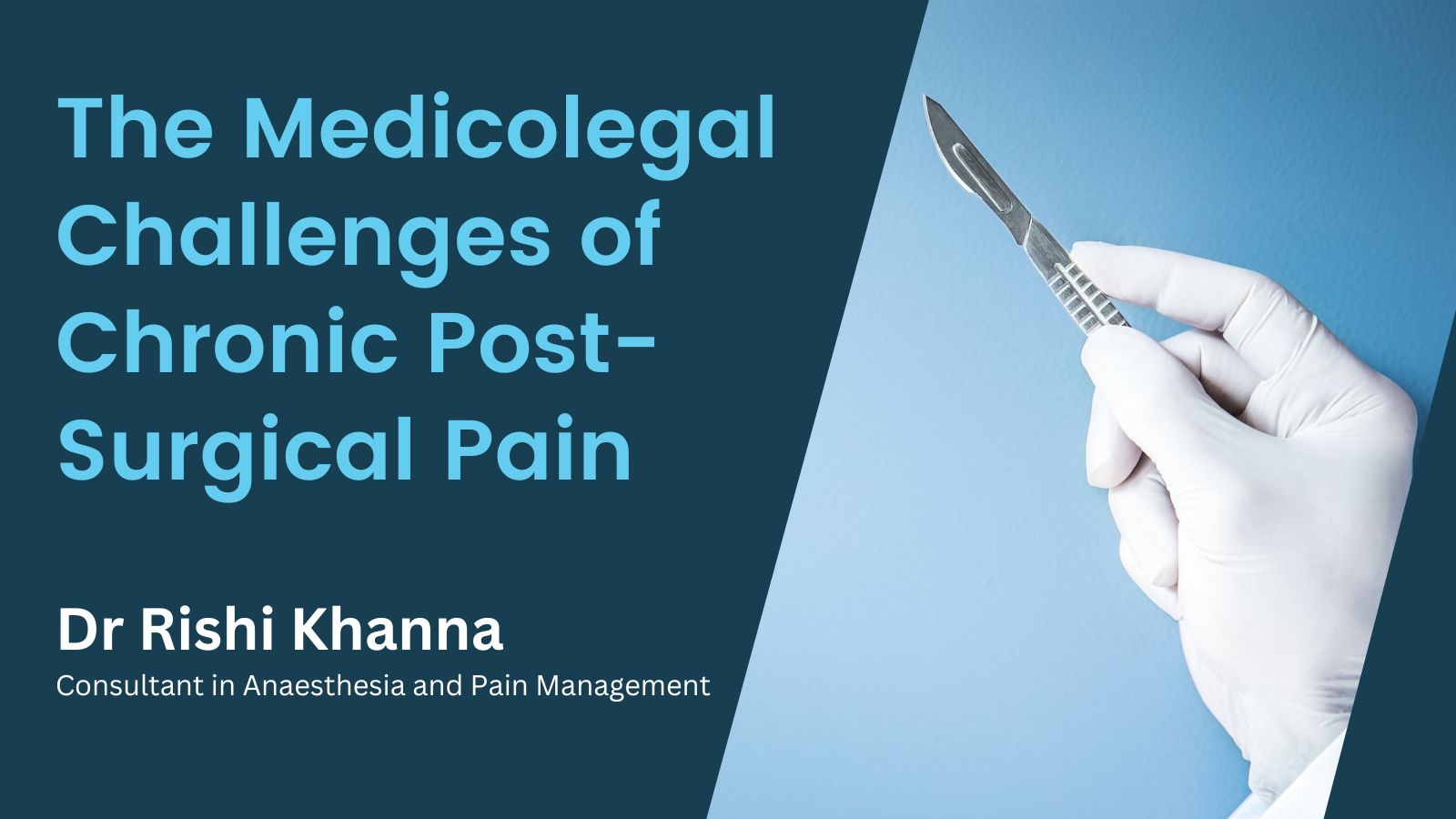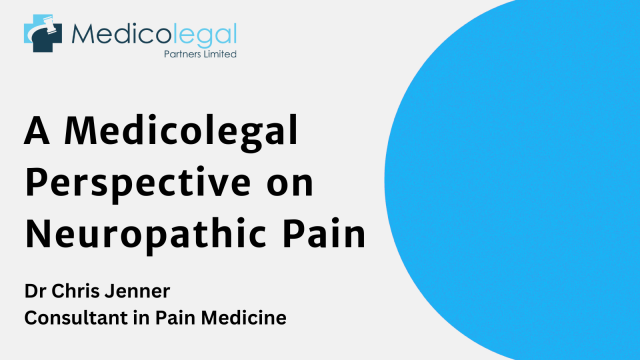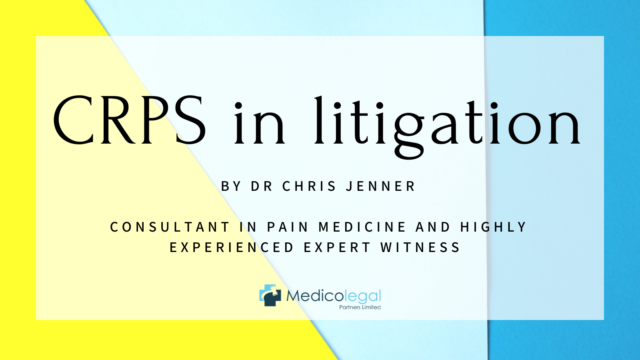The Medicolegal Challenges of Chronic Post-Surgical Pain

Surgical intervention may be required in the treatment of many illnesses and injuries. While many patients recover completely and consider surgery extremely beneficial, a significant proportion go on to develop chronic post-surgical pain (CPSP) (1-5). Chronic pain can have a significant effect on a patient’s life; it may lead to long-term opioid use, with its associated complications, and impaired functional recovery that restricts participation in daily activities (2). There is also an economic burden, as it is a major cause of early retirement and unemployment (2, 6). As many patients choose to undergo surgery to relieve pain from conditions such as joint arthritis, the risk of subsequent CPSP, along with any necessary preventive measures that should be undertaken to reduce this risk, need to be fully considered (5).
The incidence of CPSP varies widely, depending on the type of surgery, the patient population and the definition used (3), but between 5% and 85% of all surgical patients will experience it in some form (1-5). Various definitions of chronic post-surgical pain (CPSP) have been suggested over the years, but it is generally considered to be pain that develops or intensifies after a surgical procedure and is associated with the location of that surgery, lasts for 3 months or more, and cannot be explained by another cause (1-3). Mechanistically, it is impossible to distinguish CPSP from acute pain (4); it is only the timescale over which it occurs that defines it as chronic pain. Chronic post-surgical pain is generally considered to be neuropathic in origin, rather than nociceptive, meaning that it derives from damage or dysfunction in the nervous system (3, 4, 7). It typically manifests as a sharp, shooting or burning sensation and may be associated with both sensory loss and hypersensitivity (7). The pain occurs both at rest and during movement (4).
The cause of CPSP is not fully understood but is likely to be multifactorial (4). Different mechanisms probably give rise to different pain syndromes, even after the same surgical operation (3). Generally, it is thought that during the process of nerve regeneration, axonal sprouts generate neuronal activity, which is most marked when neuromas develop. The consequent barrage of signals to the spinal cord leads to central sensitisation (3, 4, 7). Furthermore, inflammatory pain at the surgical site is mediated by cytokines which leads to peripheral sensitisation. It is also thought that neuroplasticity of the nociceptive system might be an additional factor in the development of CPSP (8). However, the avoidance of nerve damage does not guarantee that CPSP will be prevented; nor does the sectioning of nerves always lead to its development (3). Numerous other risk factors can influence the likelihood of a patient developing CPSP and these can be grouped into clinical, demographic, psychological and genetic factors (3, 4, 8). Whether these risk factors are truly causal, or act instead as mediators in causal pathways, remains a subject of debate (2).
The single biggest risk factor for CPSP is the surgery itself (3). Although CPSP can occur after any type of surgical procedure, it is more likely after extensive procedures that generate a higher risk of significant injury to the nerves (4, 7, 8). Other surgical factors include longer duration of surgery, incision type, anaesthesia used, perioperative analgesia and other treatments administered (1-4, 8). However, the relationship with duration of surgery is complicated by the fact that these patients probably had more serious pathology or comorbidities that influenced both the complexity of the operation and its outcome (3). The experience of the surgeon is an additional risk factor, with patients treated in low volume, less experienced units being more likely to subsequently report CPSP (3, 4). There is recent evidence that postoperative complications predict CPSP at both 3 months and 1 year after surgery (2). CPSP is also more common following repeated operations at the same anatomical site (1, 4).
Among the demographic factors, younger age and female gender are the most important (1-4, 8). Socio-environmental risk factors for CPSP include lack of social support, low educational attainment and low income (4, 5). Psychological symptoms, including depression, catastrophising, fear, anxiety and coping skills are consistently implicated (1-6, 8), although not all studies have reported strong associations with all adverse psychological traits (9). The relationship between pain and depression is bi-directional; one can give rise to the other and when they occur together, each condition is worsened. Pain appears to alter synaptic connectivity at the prefrontal cortex and hippocampus, as well as affecting dopamine signalling from the ventral tegmental area, changes that have been shown to trigger the symptoms of depression. Recently, it has been suggested that dysfunction in the serotonergic system plays an important role in the pathophysiology of both pain and depression (6).
Evidence from genetic studies demonstrates that polymorphisms in several relevant genes appear to account for a large proportion of the inter-individual variation in pain sensitivity and treatment response (4). This suggests that some patients are predisposed to develop pain after nerve injury. Moreover, animal studies have also demonstrated that the development of neuropathic pain in mice following nerve injury is genetically determined (3). Thus, genetic variation could explain much of the variability seen in CPSP and predict individual susceptibility (8). It is now suspected that the presence of certain conditions, including fibromyalgia, migraine, irritable bowel syndrome and Raynaud’s syndrome may indicate patients who are more likely to experience chronic pain following surgery (3). Furthermore, pre-existing pain shows a strong association with CPSP, as does severe acute post-operative pain (1-5).
Recently, it has been shown that a number of the genes involved in dopaminergic (DA) neurotransmission are associated with both the prevalence and severity of CPSP. One function of DA is the modulation of nociception at the spinal dorsal horn; depending on the specific receptor targeted, signal transduction may be amplified or inhibited. Two of the receptors, D1 and D5, have been specifically implicated in the maintenance of chronic pain states. Interestingly, these are expressed differently in men and women: D1 is more involved in women and D5 in men (8).
Given the association between acute post-operative pain and CPSP, prompt management of pain should be a priority (3, 7). However, reliance on a single pharmacological option rarely gives adequate relief and many patients remain undertreated and therefore are at risk of developing CPSP (7). Instead, multimodal analgesia, tailored to both the specific surgery and patient needs, will both reduce the reliance on opioids, thereby minimising their side-effects, and lead to faster recovery (8). Pain relief should be administered for as long as the patient’s inflammatory response continues after surgery, rather than being restricted to a set time period (4, 7). Several drugs used to treat perioperative pain have been associated with a reduced risk of subsequent CPSP. These include gabapentinoids, the antidepressant venlafaxine, and some local and regional anaesthetics (3, 4, 7). Conversely, ketamine, opioids and intercostal cryoanalgesia appear to offer no benefit (7).
Once established, chronic neuropathic pain is difficult to treat (3-6, 8). The available pharmacological treatment options for CPSP offer limited benefit and are frequently associated with significant side effects (7, 8). Successful treatment usually requires a long-term multidisciplinary approach (7), involving pharmacological, physical and psychological interventions (3). Future therapeutic targets include direct modulation of DA neurotransmission, which may prevent the development of CPSP, by inhibiting the initiation and maintenance of central sensitisation, and provide a means to treat established cases (8).
Although CPSP can have medicolegal consequences (2), the assumption by many patients who develop chronic pain that something went wrong during their surgery or that their surgeon is at fault is almost always erroneous. There is also evidence that patients with CPSP who attribute blame for their pain experience more distress, a poorer response to treatment and have lower expectations about the success of future treatments for their condition (3). Although poor surgical technique can give rise to CPSP (4), it also appears to be an almost inevitable consequence of surgery in a proportion of patients. In clinical negligence, an exploration into the process of consent is particularly relevant for procedures that are traditionally associated with CPSP such as inguinal hernia repair, thoracotomy, mastectomy and knee replacement surgery. Better patient education about the likelihood of CPSP would assist patients in making informed choices about whether to proceed with surgery (3). This is important both for patients with no pre-existing pain who are considering elective surgery, and for patients with a known hypersensitivity. However, whether patients who have never experienced CPSP would consider apparently unnecessary analgesic intervention in order to prevent it remains unclear (4).
Surgical intervention is beneficial for many patients, but CPSP is a common long-term complication that can have a significant impact on the patient’s quality of life. As the available treatments for chronic pain are limited in their effectiveness and often carry significant side effects, prevention is particularly important (3, 7). However, the incidence of CPSP has not reduced over the last decade, indicating that current prevention strategies are not effective (1). As the severity of perioperative acute pain appears to be influential in the development of CPSP, patients should be offered prompt and effective pain relief for as long as necessary. Screening programmes that allow diseases to be detected earlier, resulting in less invasive surgery, may also reduce the likelihood of CPSP developing. Finally, identification of the genes responsible for pain response and subsequent CPSP may allow for preventive interventions in high-risk individuals and the development of novel targeted pain relief therapeutic strategies (8).
References
1. Fletcher D, Lavand’homme P. Towards better predictive models of chronic post-surgical pain: fitting to the dynamic nature of the pain itself. Br J Anaesth. 2022;129(3):281-4.
2. Hanley C, Ladha KS, Clarke HA, Cuthbertson BC, Wijeysundera DN. Association of postoperative complications with persistent post-surgical pain: a multicentre prospective cohort study. Br J Anaesth. 2022;128(2):311-20.
3. Macrae WA. Chronic post-surgical pain: 10 years on. Br J Anaesth. 2008;101(1):77-86.
4. Shipton EA. The transition from acute to chronic post surgical pain. Anaesth Intensive Care. 2011;39(5):824-36.
5. Wylde V, Beswick AD, Dennis J, Gooberman-Hill R. Post-operative patient-related risk factors for chronic pain after total knee replacement: a systematic review. BMJ Open. 2017;7(11):e018105.
6. Ghoneim MM, O’Hara MW. Depression and postoperative complications: an overview. BMC Surg. 2016;16:5.
7. Humble SR, Dalton AJ, Li L. A systematic review of therapeutic interventions to reduce acute and chronic post-surgical pain after amputation, thoracotomy or mastectomy. Eur J Pain. 2015;19(4):451-65.
8. van Reij RRI, Joosten EAJ, van den Hoogen NJ. Dopaminergic neurotransmission and genetic variation in chronification of post-surgical pain. Br J Anaesth. 2019;123(6):853-64.
9. Giusti EM, Lacerenza M, Manzoni GM, Castelnuovo G. Psychological and psychosocial predictors of chronic postsurgical pain: a systematic review and meta-analysis. Pain. 2021; 162(1):10-30.



